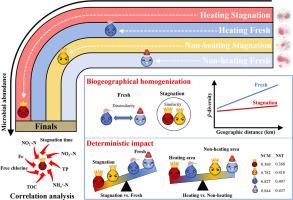水力和热性能触发水微生物组的确定性组装:从生物地理同质化到生态模型
IF 12.4
1区 环境科学与生态学
Q1 ENGINEERING, ENVIRONMENTAL
引用次数: 0
摘要
由于潜在的微生物污染,饮用点的饮用水质量长期以来一直是一个核心的公共卫生问题。然而,对自来水水力性能(停滞)的研究仍处于起步阶段,特别是对全国范围内冬季热力性能(城市供暖)的影响知之甚少。本研究探讨了停滞和城市供暖对自来水微生物群落的影响,重点研究了微生物群落组成的时空变化。结果表明,停滞显著地改变了微生物群落,特别是在加热地区,温度加剧了微生物的生长。此外,停滞和城市供暖驱动了微生物群落的确定性组装过程,这可以从β-多样性、归一化随机比(NST)和中性群落模型(NCM)拟合的降低中得到证明。机器学习模型显示,停滞时间大于8小时会导致群落丰度增加,因为接触有机物质和营养物质的时间更长。该研究结果说明了环境影响对微生物群落动态的重要性,并为自来水微生物群落提供了有价值的见解,特别是在长期停滞的地区。本文章由计算机程序翻译,如有差异,请以英文原文为准。


Hydraulic and thermal performance trigger the deterministic assembly of water microbiomes: From biogeographical homogenization to machine learning model
Water quality at the point of consumption has long been a health issue because of the potential for microbial ecology. However, research on water hydraulic performance remains in its infancy, and in particular, little is known about the effects of thermal performance during winter. This study explored the effects of stagnation and municipal heating on microbial communities in tap water, focusing on spatial and temporal variations in microbial community composition. The results revealed that stagnation significantly alters the microbial community, especially in heating areas, where the temperature exacerbates microbial growth. Furthermore, hydraulic and thermal performance drive deterministic assembly processes in microbial communities, as evidenced by the reductions in β-diversity, normalized stochasticity ratio (NST), and neutral community model (NCM) fit. Machine learning models revealed that stagnation time greater than 8 h results in increased community abundance because of longer exposure to organic matter and nutrients. The study finding illustrate the importance of environmental influences on microbial community dynamics, and provide valuable insights into the water microbial community, particularly in areas with prolonged stagnation.
求助全文
通过发布文献求助,成功后即可免费获取论文全文。
去求助
来源期刊

Water Research
环境科学-工程:环境
CiteScore
20.80
自引率
9.40%
发文量
1307
审稿时长
38 days
期刊介绍:
Water Research, along with its open access companion journal Water Research X, serves as a platform for publishing original research papers covering various aspects of the science and technology related to the anthropogenic water cycle, water quality, and its management worldwide. The audience targeted by the journal comprises biologists, chemical engineers, chemists, civil engineers, environmental engineers, limnologists, and microbiologists. The scope of the journal include:
•Treatment processes for water and wastewaters (municipal, agricultural, industrial, and on-site treatment), including resource recovery and residuals management;
•Urban hydrology including sewer systems, stormwater management, and green infrastructure;
•Drinking water treatment and distribution;
•Potable and non-potable water reuse;
•Sanitation, public health, and risk assessment;
•Anaerobic digestion, solid and hazardous waste management, including source characterization and the effects and control of leachates and gaseous emissions;
•Contaminants (chemical, microbial, anthropogenic particles such as nanoparticles or microplastics) and related water quality sensing, monitoring, fate, and assessment;
•Anthropogenic impacts on inland, tidal, coastal and urban waters, focusing on surface and ground waters, and point and non-point sources of pollution;
•Environmental restoration, linked to surface water, groundwater and groundwater remediation;
•Analysis of the interfaces between sediments and water, and between water and atmosphere, focusing specifically on anthropogenic impacts;
•Mathematical modelling, systems analysis, machine learning, and beneficial use of big data related to the anthropogenic water cycle;
•Socio-economic, policy, and regulations studies.
 求助内容:
求助内容: 应助结果提醒方式:
应助结果提醒方式:


